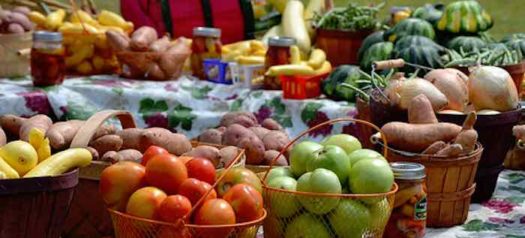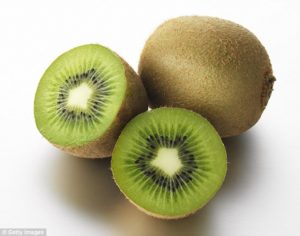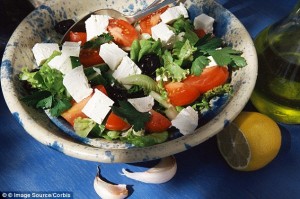Over the past couple of years, we have amassed hundreds of articles addressing food and nutrition for a wide range of our health needs. About once a week we are going to offer a series of headlines and brief synopsis of a number of these columns. Welcome to Dr. Kelley’s Kitchen. ~ J.B.
 Time to slap on the BROCCOLI?
Time to slap on the BROCCOLI?
Before heading out in the sun, most people apply a bit of sunscreen to their exposed skin. However, a new study suggests that broccoli could be just as effective. When rubbed directly into the skin, broccoli could also reduce the chance of a person developing skin cancer, the researchers believe… (Continue to full article)
 They’re berry good for you! Berries to boost your memory
They’re berry good for you! Berries to boost your memory
Have you embraced the newest super-berry on the block? The Scandinavian lingonberry — a dark red soft fruit. Research shows drinking the juice can dramatically lower your blood pressure. Long a feature of Nordic diets, you can find lingonberry products in Ikea, Lidl and health food stores. But when it comes to a health boost, all berries pack a powerful punch — and have some rather surprising benefits… (Continue to full article)
 Watercress, spinach and chicory are the most nutritious vegetables you can eat
Watercress, spinach and chicory are the most nutritious vegetables you can eat
We all know that fruit and vegetables are good for us – but just how good? A new league table, showing the nutrient density of different fruits and vegetables, has been drawn up by diet experts – and watercress has come out on top. The researchers, from the William Paterson University of New Jersey, aimed to define ‘powerhouse fruit and vegetables’… (Continue to full article)
7 Foods We Should Be Eating But Aren’t
The standard American diet needs to be revamped. Aside from eating more fruits and vegetables and less sugar, there are many less mainstream (and often misunderstood) foods that we should be eating — either for health, environmental, or economic reasons — but are not. Here’s a short list… (Continue to full article)
 The Amazing Health Benefits Of Peppermint
The Amazing Health Benefits Of Peppermint
Peppermint is a common garden herb known for its primary active ingredient, menthol — which provides a cooling sensation and is used to relieve pain and irritation, while also preventing infection. (It’s found in cigarettes and cigars, too.)… (Continue to full article)
 Thyme: A Powerful Natural Antiseptic
Thyme: A Powerful Natural Antiseptic
For ancient Rome, thyme was believed to “promote vigor” and was used in their baths or spas. In Europe, singers even today, follow the tradition of gargling with thyme, marjoram and honey tea to preserve their voices. Thyme along with sage and marjoram are recommended to use as a gargle; to relieve laryngitis, tonsillitis, clogged sinus and lung congestion…. (Continue to full article)
 Here’s what happened when I drank a green smoothie instead of coffee every morning for a week
Here’s what happened when I drank a green smoothie instead of coffee every morning for a week
when my editor recently asked our team to try a popular morning-productivity hack for a week and report on the results, the thought of changing anything about my routine gave me the chills. I didn’t particularly want to sacrifice my luxurious 7:30 a.m. wake-up call or make room for intense exercise, so I chose to hack my mornings by eating superfoods. Specifically, I decided to drink those obnoxiously green smoothies you see health nuts walking around with after their workout… (Continue to full article)
Life, Liberty & Your Good Health is heard at 1:00 p.m. (Eastern Time) for TWO-HOURS, each Wednesday on The Micro Effect.

Kettle Moraine, Ltd.
P.O. Box 579
Litchfield Park, AZ 85340
1-623-327-1778
Email: [email protected]
 Most potatoes we eat today have 100 percent less vitamin A than potatoes did in the 1950s. One hundred percent. That may sound unbelievable, but it doesn’t end there.
Most potatoes we eat today have 100 percent less vitamin A than potatoes did in the 1950s. One hundred percent. That may sound unbelievable, but it doesn’t end there.
 Eating a diet rich in fruits and vegetables can help lower calorie intake, reduce risks for heart disease, obesity and Type 2 diabetes, and protect against certain cancers.
Eating a diet rich in fruits and vegetables can help lower calorie intake, reduce risks for heart disease, obesity and Type 2 diabetes, and protect against certain cancers. 7 Amazing Diabetic Foods that Don’t Feel “Healthy”
7 Amazing Diabetic Foods that Don’t Feel “Healthy” Is Pink Himalayan Salt Better Than Regular Salt?
Is Pink Himalayan Salt Better Than Regular Salt? How Energy Drink Makers are Causing Overdoses and Deaths
How Energy Drink Makers are Causing Overdoses and Deaths Mushroom Powders Linked To Heart Health Benefits
Mushroom Powders Linked To Heart Health Benefits

 The secret to a good night’s sleep could lie in kiwi fruit.
The secret to a good night’s sleep could lie in kiwi fruit.
 Many of us suffer from bad breath, cracked lips and agonising headaches. But they could all be a sign of something much more sinister.
Many of us suffer from bad breath, cracked lips and agonising headaches. But they could all be a sign of something much more sinister. Had a heavy night drinking?
Had a heavy night drinking? Revealed: The foods that keep you slim as you age
Revealed: The foods that keep you slim as you age
 Time to slap on the BROCCOLI?
Time to slap on the BROCCOLI? They’re berry good for you! Berries to boost your memory
They’re berry good for you! Berries to boost your memory Watercress, spinach and chicory are the most nutritious vegetables you can eat
Watercress, spinach and chicory are the most nutritious vegetables you can eat The Amazing Health Benefits Of Peppermint
The Amazing Health Benefits Of Peppermint Thyme: A Powerful Natural Antiseptic
Thyme: A Powerful Natural Antiseptic Here’s what happened when I drank a green smoothie instead of coffee every morning for a week
Here’s what happened when I drank a green smoothie instead of coffee every morning for a week Chamomile, a common herb used in teas, can calm muscle spasms, relieve menstrual cramps, ease nerves, soothe an upset stomach, promote healthy skin and even help you sleep.
Chamomile, a common herb used in teas, can calm muscle spasms, relieve menstrual cramps, ease nerves, soothe an upset stomach, promote healthy skin and even help you sleep.

 Gluten intolerance occurs when the body, specifically the digestive tract, responds to the presence of gluten in food. The response can range from mild discomfort to serious medical complications. Awareness is continuing to rise regarding the problems caused by gluten, even for people who do not suffer from a gluten allergy.
Gluten intolerance occurs when the body, specifically the digestive tract, responds to the presence of gluten in food. The response can range from mild discomfort to serious medical complications. Awareness is continuing to rise regarding the problems caused by gluten, even for people who do not suffer from a gluten allergy. Are you doing what you can to nourish your brain?
Are you doing what you can to nourish your brain? A new study has provided evidence that the so-called “Mediterranean diet” can help prevent the loss of brain volume in older people.
A new study has provided evidence that the so-called “Mediterranean diet” can help prevent the loss of brain volume in older people.